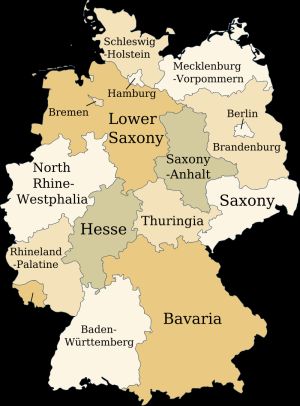Julius’s Ancestral Home
4
Thuringia, officially the Free State of Thuringia (German: Freistaat Thüringen), is located in central Germany. It has an area of 16,171 square kilometers (6,243.7 sq mi) and 2.29 million inhabitants, making it the sixth smallest by area and the fifth smallest by population of Germany’s sixteen Bundesländer (federal states). The capital is Erfurt.
Geography
Thuringia borders on the German states of Lower Saxony, Saxony-Anhalt, Saxony, Bavaria and Hesse.

The ridges of the western Harz Mountains divide the region from Lower Saxony on the north-west, while the eastern Harz similarly separates Thuringia from the state of Saxony-Anhalt to the north-east. To the south and southwest, the Thuringian Forest effectively separates the ancient region of Franconia, now the northern part of Bavaria, from the rolling plains of most of Thuringia. The central Harz range extends southwards along the western side into the northwest corner of the Thuringian Forest region, making Thuringia a lowland basin of rolling plains nearly surrounded by ancient somewhat-difficult mountains. To the west across the mountains and south is the drainage basin of the Rhine River.
The most conspicuous geographical feature of Thuringia is the Thuringian Forest, a mountain chain in the southwest. The Werra River, a tributary of the Weser River, separates this mountain chain from the volcanic Rhön Mountains, which are partially in Thuringia, Bavaria, and Hesse. In the northwest, Thuringia includes a small part of the Harz. The eastern part of Thuringia is generally a plain. The Saale River runs through these lowlands from south to north.
History
Named after the Thuringii tribe who occupied it ca. AD 300, Thuringia came under Frankish domination in the 6th century, forming a part of the subsequent Holy Roman Empire.
Thuringia became a landgraviate in 1130. After the extinction of the reigning Ludowingian line of counts in 1247 and the War of the Thuringian Succession (1247–1264), the western half became independent under the name of Hesse, never to become a part of Thuringia again. Most of the remaining Thuringia came under the rule of the Wettin dynasty of the nearby Margraviate of Meissen, the nucleus of the later Electorate and Kingdom of Saxony. With the division of the house of Wettin in 1485, Thuringia went to the senior Ernestine branch of the family, which subsequently subdivided the area into a number of smaller states, according to the Saxon tradition of dividing inheritance amongst male heirs. These were the “Saxon duchies“, consisting, among others, of the states of Saxe-Weimar, Saxe-Eisenach, Saxe-Jena, Saxe-Meiningen, Saxe-Altenburg, Saxe-Coburg, and Saxe-Gotha; Thuringia became merely a geographical concept.
Thuringia generally accepted the Protestant Reformation. The Catholic faith was abolished as early as 1520; priests that remained loyal were driven away and churches and monasteries were largely destroyed, especially during the Peasants’ War of 1525. In Mühlhausen and elsewhere, the Anabaptists found many adherents. Thomas Munzer, a leader of some non-peaceful groups of this sect, was active in this city. Within the borders of Thuringia the Catholic faith was maintained only in the district called Eichsfeld, which was ruled by the Archbishop of Mainz, and to a small degree in the city and vicinity of Erfurt.
Information Source
This chapter was abstracted from Wikipedia: Thuringia
